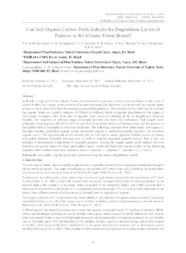Can soil organic carbon pools indicate the degradation levels of pastures in the Atlantic Forest biome.
Can soil organic carbon pools indicate the degradation levels of pastures in the Atlantic Forest biome.
Autoria: ROCHA JUNIOR, P. R. da; DONAGEMMA, G. K.; ANDRADE, F. V.; PASSOS, R. R.; BALIEIRO, F. de C.; MENDONÇA, E. de S.; RUIZ, H. A.
Resumo: In Brazil, a large part of the Atlantic Forest was deforested in pastures, which were developed on the basis of natural fertility and organic matter content of the new deforested soil. However, as time went by the organic matter content in these areas have been decreasing causing soil degradation. The objective of this study was to evaluate the organic matter as a quality indicator of Ultisols in different levels of pasture degradation in the region of Governador Valadares-MG. Four sites of pastures were chosen at different levels of degradation, observed visually, two capoeiras in different stages of natural recovery and forest site (reference). Soil samples were collected at three depths (0.00-0.05, 0.05-0.10 and 10-0.20 m) in two seasons of the year (rainy and dry seasons) in the middle third of the landform with three replicates. The following attributes were determined: soil organic C, free light fraction, particulate organic matter, particulate organic C, mineral-associated organic C and dissolved organic matter. The experimental results showed that the soil organic matter appeared efficient in discriminating soil quality between degraded forest/pasture, as well as between degraded capoeira/pasture. But, it was not sensitive to discriminate within levels of degraded pastures. Among the organic matter pools studied, the most sensitive soil quality indicators were: particulate organic matter and dissolved organic matter, in the following degraded order verified from these indicators: forest < capoeira 1 = capoeira 2 < pastures (1, 2, 3 and 4).
Ano de publicação: 2014
Tipo de publicação: Artigo de periódico
Unidade: Embrapa Solos
Palavras-chave: Organic matter pool, Ultisols, degradation, particulate organic matter, soil quality
Observações
1 - Por padrão são exibidas publicações dos últimos 20 anos. Para encontrar publicações mais antigas, configure o filtro ano de publicação, colocando o ano a partir do qual você deseja encontrar publicações. O filtro está na coluna da esquerda na busca acima.
2 - Para ler algumas publicações da Embrapa (apenas as que estão em formato ePub), é necessário ter, no celular ou computador, um desses softwares gratuitos. Sistemas Android: Google Play Livros; IOS: iBooks; Windows e Linux: software Calibre.
Acesse outras publicações
Acesse a Base de Dados da Pesquisa Agropecuária (BDPA) para consultar o acervo completo das bibliotecas da Embrapa.

